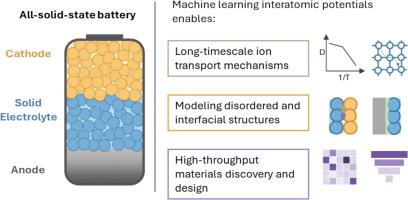Redefining atomistic simulations of all-solid-state batteries through machine learning interatomic potentials
IF 14.9
1区 化学
Q1 Energy
引用次数: 0
Abstract
All-solid-state batteries (ASSBs) represent a next-generation energy storage technology, offering enhanced safety, higher energy density, and improved cycling stability compared to conventional liquid-electrolyte-based lithium-ion batteries. Understanding and optimizing the complex chemistries and interfaces that underpin ASSB performance present significant challenges from both experimental and modeling perspectives. In particular, atomistic simulations face difficulties in capturing the complex structure, disorder, and dynamic evolution of materials and interfaces under practically relevant conditions. While established methods such as density functional theory and classical force fields have provided valuable insights, some questions remain difficult to address, particularly those involving large system sizes or long timescales. Recently, machine learning interatomic potentials (MLIPs) have emerged as a transformative tool, enabling atomistic simulations at length and time scales that were previously challenging to access with conventional approaches. By delivering near first-principles accuracy with much greater efficiency, MLIPs open new avenues for large-scale, long-timescale, and high-throughput simulations of solid-state battery materials. In this review, we present a comparative overview of density functional theory, classical force fields, and MLIPs, highlighting their respective strengths and limitations in ASSB research. We then discuss how MLIPs enable simulations that reach longer timescales, larger system sizes, and support high-throughput calculations, providing unique insights into ion transport and interfacial evolution in ASSBs. Finally, we conclude with a summary and outlook on current challenges and future opportunities for expanding MLIP capabilities and accelerating their impact in solid-state battery research.

通过机器学习原子间电位重新定义全固态电池的原子模拟
与传统的液体电解质锂离子电池相比,全固态电池(assb)代表了下一代储能技术,具有更高的安全性、更高的能量密度和更好的循环稳定性。从实验和建模的角度来看,理解和优化支撑ASSB性能的复杂化学和接口都是一项重大挑战。特别是,在实际相关条件下,原子模拟难以捕捉材料和界面的复杂结构、无序和动态演变。虽然现有的方法,如密度泛函理论和经典力场提供了有价值的见解,但一些问题仍然难以解决,特别是那些涉及大系统规模或长时间尺度的问题。最近,机器学习原子间势(MLIPs)已经成为一种变革性的工具,能够在长度和时间尺度上实现以前用传统方法难以获得的原子模拟。通过提供接近第一性原理的精度和更高的效率,MLIPs为大规模、长时间和高通量的固态电池材料模拟开辟了新的途径。在这篇综述中,我们对密度泛函理论、经典力场和MLIPs进行了比较综述,强调了它们在ASSB研究中的各自优势和局限性。然后,我们讨论了MLIPs如何使模拟达到更长的时间尺度,更大的系统尺寸,并支持高通量计算,为assb中的离子传输和界面演变提供独特的见解。最后,我们总结并展望了扩展MLIP能力和加速其在固态电池研究中的影响的当前挑战和未来机遇。
本文章由计算机程序翻译,如有差异,请以英文原文为准。
求助全文
约1分钟内获得全文
求助全文
来源期刊

Journal of Energy Chemistry
CHEMISTRY, APPLIED-CHEMISTRY, PHYSICAL
CiteScore
19.10
自引率
8.40%
发文量
3631
审稿时长
15 days
期刊介绍:
The Journal of Energy Chemistry, the official publication of Science Press and the Dalian Institute of Chemical Physics, Chinese Academy of Sciences, serves as a platform for reporting creative research and innovative applications in energy chemistry. It mainly reports on creative researches and innovative applications of chemical conversions of fossil energy, carbon dioxide, electrochemical energy and hydrogen energy, as well as the conversions of biomass and solar energy related with chemical issues to promote academic exchanges in the field of energy chemistry and to accelerate the exploration, research and development of energy science and technologies.
This journal focuses on original research papers covering various topics within energy chemistry worldwide, including:
Optimized utilization of fossil energy
Hydrogen energy
Conversion and storage of electrochemical energy
Capture, storage, and chemical conversion of carbon dioxide
Materials and nanotechnologies for energy conversion and storage
Chemistry in biomass conversion
Chemistry in the utilization of solar energy
 求助内容:
求助内容: 应助结果提醒方式:
应助结果提醒方式:


